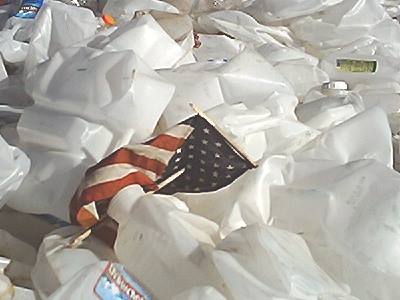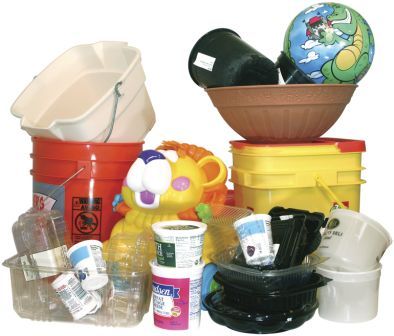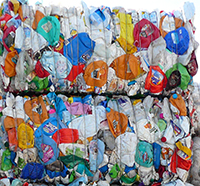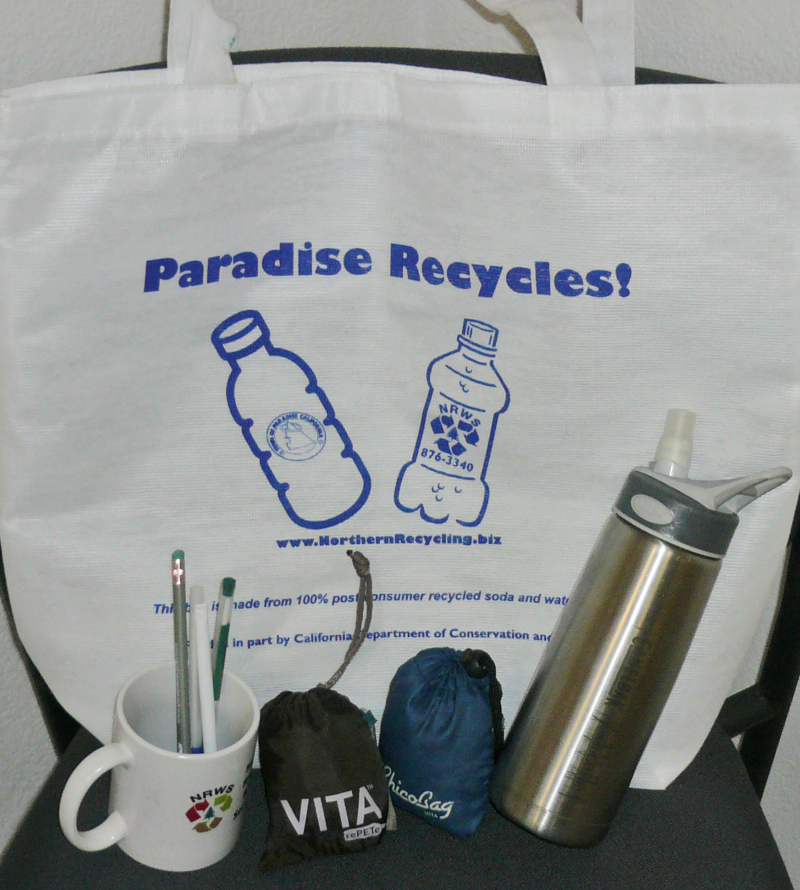plastics
 Plastic products are everywhere in today's world
Plastic products are everywhere in today's world
They may be convenient, but they have a large impact on the environment. All plastics come from petroleum, most contain potentially harmful chemical additives, and many are difficult to recycle.
Plastic doesn't decompose and litters the earth - a large section of the Pacific Ocean more than twice the size of California is now a giant sea of floating plastic trash.
Deciding what to do about plastics can be confusing. Here are some answers to a few frequently asked questions about plastics recycling:

what plastics can I put in my blue cart?
NRWS residents, schools, and businesses can recycle all rigid plastics, including bottles, jugs, buckets, tubs, bins and toys!
There is no need to look at the number on the bottom - Click here for details on our single-stream recycling program.
Styrofoam, plastic bags, and plastic film/wrap are not accepted. Businesses with a large amount of shrink wrap can call our office to set up special recycling services.
Also, please realize that many plastic items (pens, straws, lip balm containers, etc.) are so small that they can't be picked out by our workers or fall through our recycling equipment...but we will successfully recycle the majority of the plastics placed in the blue cart.
Styrofoam & Plastic bags...why can't i recycle them
There are virtually no markets for used Styrofoam - it is too light to transport cost effectively and has limited uses. Large amounts of clean Styrofoam can be recycled at Timbron International in Stockton, where they recycle it into premium interior molding products.
.jpg) Styrofoam peanuts make a huge mess when dumped in recycling or trash carts - please check out reuse options on our Styrofoam page.
Styrofoam peanuts make a huge mess when dumped in recycling or trash carts - please check out reuse options on our Styrofoam page.
Plastic bags, film, and wrap also can litter the environment when placed in carts, and get tangled in the recycling equipment if they make it to our facility.
Use reusable bags whenever possible, and recycle bags/film/wrap at stores if you end up with a stash. We encourage you to avoid purchasing hard-to-recycle plastics and buy in bulk to avoid excess packaging. Our "Recycling Guide" page lists ideas and links for environmentally friendly purchasing.
 what do the numbers inside the recycling sign mean?
what do the numbers inside the recycling sign mean?
There are thousands of types of plastic, but we've now made it easier to recycle by accepting all rigid plastics, regardless of the number.
Wondering why the numbering system is so baffling? A deli tray may be branded with a #1 (just like a water bottle), yet it contains different dyes, softeners, and other chemicals required to shape it into a tray. This mix of additives changes the properties of the plastic and makes it incompatible with the plastic used to make bottles.
To add to the confusion, the plastics industry's use of the chasing arrows with its numbering system leads most to believe that any container with arrows is recyclable. The industry says it never intended the symbol to indicate that a container was recyclable or had recycled content, but simply used it as a catchy graphic to highlight the identifying number. Recyclers requested that plastic container manufacturers change the graphic since it is misleading, but the industry has resisted efforts to modify it.
We've now found a market for more of these plastics, but we still need to sort them into many different categories before they can be shipped of for recycling. Interested in seeing how this happens...call for a tour of our facility.
 how can recycling help fight global warming?
how can recycling help fight global warming?
Recycling and composting are easy and efficient methods to save energy and reduce the production of greenhouse gases. Last year, nearly 97,000 tons of materials were recycled or composted at the our Recycling & Composting Facility. By keeping these valuable resources out of the landfill, we decreased carbon dioxide emissions by 110,290 metric tons and used 678,781 million fewer BTUs of energy. To put it in perspective, this is enough energy to power all the houses in Paradise for almost six months! Additionally, these savings are the equivalent of taking 20,200 passenger cars off the road and conserving over 12 million gallons of gasoline, helping to reduce our dependency on fossil fuels.
Plastic is made from oil, a finite resource that has contributed to global climate change. Even though recycling plastic bottles helps, consider the true environmental cost of manufacturing a plastic water bottle in the first place: it generates 100 times more toxic emissions than manufacturing a glass bottle. And unlike glass, paper products and metals, which are recycled over and over again, plastics are usually “down cycled” into non-recyclable materials such as plastic lumber. So what can you do? Here are some easy ways to help cool the earth: drink tap water, purchase products made of recycled materials, start a backyard compost pile, use canvas grocery bags and recycle & reuse at home & work.
 More ways to reduce and reuse plastic
More ways to reduce and reuse plastic
-
Bring unbroken plant pots back to your nursery
-
Recycle printer cartridges at local schools or stores
-
Buy wine with natural corks or metal screw tops instead of plastic corks
-
Use reusable metal water bottles instead of buying bottled water
-
New! Recycle your used Brita water filters
-
Bag the plastic bag - find helpful tips at www.igotmybag.org
-
Purchase items like yogurt in larger containers instead of single-serving size
-
Reuse your plastic food containers for leftovers instead of buying new ones
-
Encourage companies to take responsibility for their unsustainable packaging
